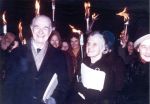
Later Years: Molecular Disease and Orthomolecular Medicine
Collection materials relating to orthomolecular medicine are of a different nature from those which chronicle Pauling’s early and middle career. Much of the material has to do with Pauling’s analysis of the work of others, and comprises papers and reports he collected, with occasional notes made in their margins and entries about them in research notebooks. Also included are notes and typescripts for many speeches by Pauling on this topic, which give insight into his thinking, as well as correspondence. The collection also includes a few materials from earlier years which prefigure orthomolecular medicine.
Pauling established his reputation based on crystallographic analysis of inorganic compounds, but he began a side-interest in biology in the mid-1930s, and in the late 1930s, he and Robert Corey, working on keratin, tried to determine a protein structure. By comparison to the inorganic molecules the structures of which Pauling had determined, protein molecules are enormously large and complex. (Hager comments, on p.189 of Force of Nature, "in the early 1930s no one knew how proteins worked or even what they looked like.")
In the 1930s, Pauling and Alfred Mirsky discovered the characteristics of the denaturation of proteins, and Pauling and Niemann competed with Dorothy Wrinch to determine the structure of amino acids. Pauling became interested in hemoglobin and in antibodies, and continued some work in this area during the interruptions of World War II. As the war concluded, he went back to his keratin research and in 1948 he made his discovery of the alpha helix structure of this protein (although he did not announce this until 1950). By 1949 he had taken his hemoglobin research to the point of identifying sickle cell anemia as a molecular disease. Pauling and his co-researchers studied keratin, silk, hemoglobin, and collagen, and published many protein papers in the 1950s.
Pauling would later move from this research on the structural properties of organic molecules to the physiological effects of nutrients at the molecular level. There has been little analysis of how these stages of his scientific interests may be related.
See the Catalogue for a complete listing of orthomolecular medicine materials in Subseries 11 of the Science section. Selected examples of these materials follow, with emphasis on Pauling’s own notes.
Table of Contents
- Introduction
- Ways to Approach the Curriculum
- Using Archival Materials in Special Collections
- Early Years: Education, Teaching and the Chemical Bond
- Middle Years: War Work, Peace Work and Protein Structure
- Later Years: Molecular Disease and Orthomolecular Medicine
- Introduction
- Part I: 1966-1969
- Part II: 1970-1979
- Part III: 1980-1994
- Topical Readings
- Websites Regarding Linus Pauling
- Appendix: General Guidelines for Use of Special Collections Materials
- Acknowledgements


